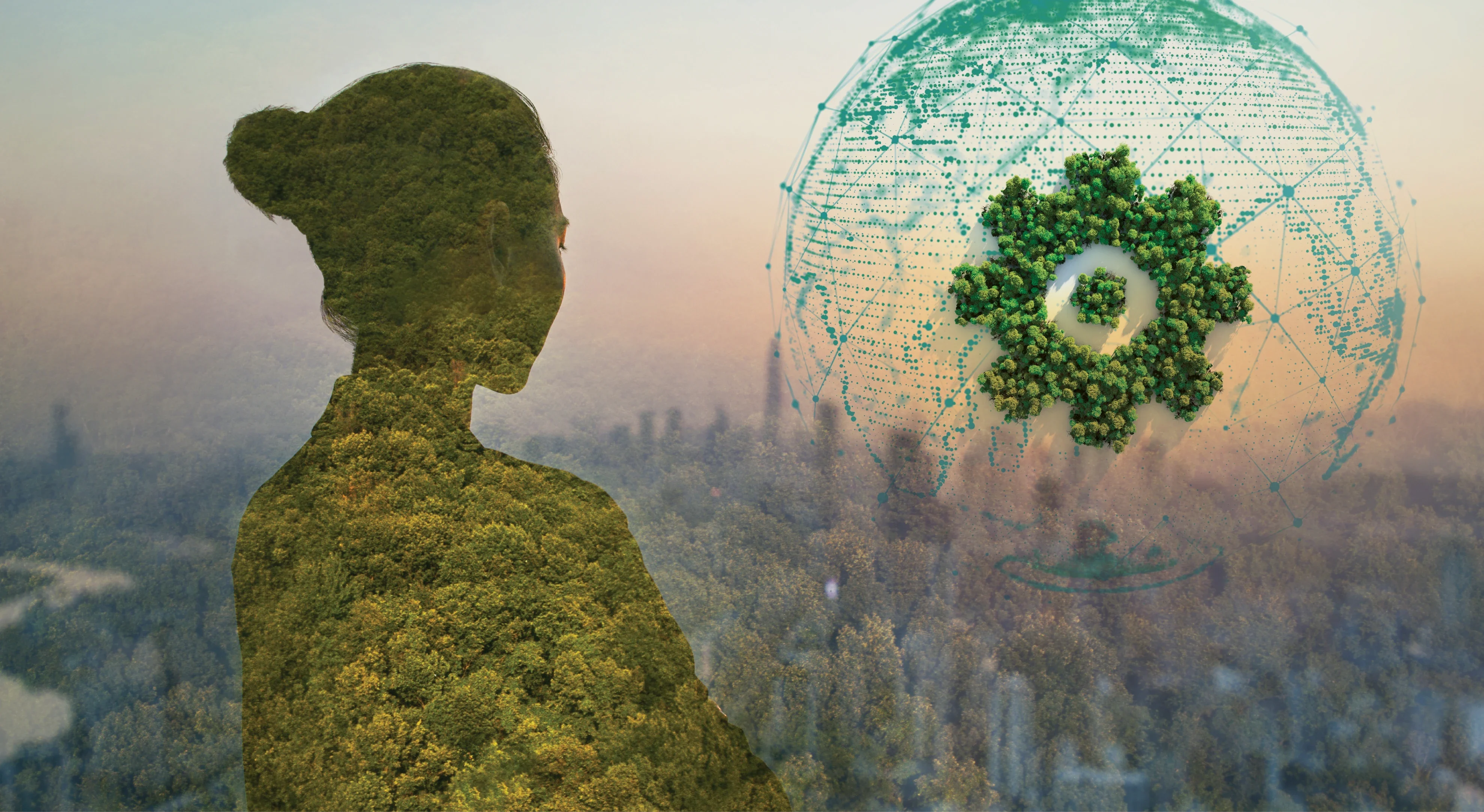GESDA defines eco-augmentation as “humans’ deliberate and strategic interactions with nature for more resilient and sustainable social-ecological systems”. Thus defined, this concept aims to serve as a platform for the sciences that navigate the fine balance between repairing and enhancing natural systems, focusing on three primary dimensions:
- “Reading and writing ecosystems” captures technological advances in synthetic biology, gene-editing and ecological modelling to monitor, understand and manipulate ecosystems.
- “Transitioning ecosystems” refers to the constant flux in ecosystems, which must be understood and managed to maintain their good functioning.
- “Hacking co-evolution” means steering the evolutionary dynamics between human societies and natural ecosystems toward beneficial outcomes.
Central to eco-augmentation are questions combining normative and descriptive aspects, such as: why and how should we “augment” nature? For whose benefit is this augmentation intended? Which elements of natural systems should be chosen for augmentation? Such questions probe into the intrinsic, relational and instrumental values of nature underlying eco-augmentation, which will depend on whether the chosen framing is, for example, conservation, restoration or recreation. The perspectives of different stakeholders, whether ecocentric, biocentric, zoocentric or anthropocentric, and the nature of the ecosystems involved are also crucial in this context.
Altogether, these dimensions form the conceptual landscape of eco-augmentation, the subject of this year’s Philosophy Lens. To do so, we will focus on the three fundamental questions driving GESDA’s anticipation of scientific and technological advancements for an inclusive and global sustainable future:
- Who are we, as humans?
- How can we all live together, as societies?
- How can we ensure the well-being of humankind and the sustainable future of our planet?
These questions will guide our analysis of the key notions at stake in eco-augmentation — namely, humans, nature and their interactions. Environmental philosophy will play an instrumental role in our analysis, characterised as a hybrid discipline that draws on the philosophy of science, epistemology and ethics to examine fields that range from conservation biology to synthetic biology via restoration ecology.
In this process, our approach will be honest knowledge brokering: while mapping the key notions at stake in eco-augmentation, we will always strive for value-neutrality, acknowledging that every position is laden with values without taking a stance. Thereby, we will seek to open the solution space of action and opportunities for society and decision-makers, enabling them to “use the future to build the present.”
Humans and nature
In eco-augmentation, humans are “humans-in-nature”, so we should begin by examining the roles and identities of humans within the Anthropocene and the evolving concept of nature, asking: “Who are we, as humans?” and “What is nature?”
First, the human aspect. Eco-augmentation is deeply rooted in the concept of the Anthropocene, a term first coined by Dutch meteorologist Paul J. Crutzen at a meeting of the International Geosphere-Biosphere Programme (IGBP) in February 2000. "Anthropocene" acknowledges the distinct impact that humans are having on the environment, evident in measurable changes such as global warming and biodiversity loss. In so doing, it challenges traditional dualisms about humans, nature and technology, and fosters cross-disciplinary collaborations that span different timescales, from Earth-system science and geology to social sciences and humanities.
As “geobiophysical” transformative agents in the Anthropocene, humans possess unprecedented abilities to shape and sustain new social-ecological environments. This transformative power, coupled with cultural and technological advancements, positions us as the Earth’s “ultimate ecosystem engineers”, for better or worse. A critical dilemma therefore arises: should we harness or restrain our own human nature? Addressing this dilemma is crucial for responsible eco-augmentation.
Conflicting visions vie for the future Anthropocene, varying from ecomodernist techno-utopism to convivialist degrowth. While the idea of a good Anthropocene might still sound like an oxymoron, it can serve as an aspirational goal for transforming human-nature relationships. This will be key for a sustainable living-together in eco-augmentation.
We can now turn to the question of nature. The concept of “nature” is imbued with various meanings and values across cultures and times. Recognising the sociocultural and historical frames that influence how we perceive and relate to nature will prove another essential step in eco-augmentation.
Conceptualisations of nature across cultures generally cluster into three perspectives:
- an inclusive universe where humans are integral parts of nature
- an exclusive environment where humans are separate from nature
- a deified nature with spiritual dimensions
The notion of nature as a static, passive and exclusive environment remains largely a Western exception to global cultural norms. The more prevalent view is of anthropogenic nature, a dynamic and active space shaped by humans. These varying perspectives intersect with how societies value nature, across a spectrum ranging from intrinsic values, where nature is valued for its own sake, to instrumental values, where nature is valued for its utility to humans, via relational values, which emphasise meaningful relationships between humans and nature.
Understanding these diverse cultural conceptualisations and values is again essential when engaging in eco-augmentation practices. Environmental policy frameworks have indeed long rested on a monocultural dichotomy-based conception of nature, unsuited to manage Anthropocenic uncertainties about unpredictable futures. In eco-augmentation, new conceptions of nature are therefore needed. Shifting away from stability to resilience will be crucial.
Ensuring the future of our planet
Once humans and nature are in place, we can turn to their relationships, asking “How can we ensure the well-being of humankind and the sustainable future of our planet?”
Eco-augmentation targets the coupled dynamics of human sociocultural systems and natural ecological systems. These social-ecological systems are characterised by emergence, where self-organisation among heterogeneous components leads via complex processes to new system-level properties, behaviours and capacities. Feedback between the sociocultural and environmental elements leads to the reciprocal adaptation of both. This process of co-evolution fosters resilient and sustainable systems in the face of ongoing change. Previous views of nature have assumed it to be teleological, mechanistic or deterministic — designed or directed towards a particular, defined set of outcomes. The social-ecological co-evolutionary perspective, on the other hand, takes a view that is open-ended, non-deterministic and inherently unpredictable.
A key driver for such co-evolution is social-ecological niche construction. Niche construction is the process by which organisms modify their environment in ways which alter the evolutionary selection pressures acting on them. In the context of social-ecological coevolution, it emphasises causal interrelationships between sociocultural and environmental processes across three dimensions:
- social-ecological causation, which focuses on the symmetric dynamics of niche construction
- social-ecological inheritance, which encompasses parallel inheritance mechanisms within ecological, social-ecological and sociocultural systems
- cross-social-ecological indirect effects, which consider how distant niches influence one another globally
These dimensions highlight ethical considerations of interspecies, intergenerational and intragenerational justice, which further increase as the scale and scope of humans’ activity exceeds our niche construction capacities, potentially leading to self-destruction and social-ecological lock-ins.
In the context of eco-augmentation, niche construction aimed at serving human needs will have to be redirected to serve “others” in addition: “regenerative niche construction”. The key will be hacking social-ecological dynamics through purposefully engineered and self-reinforcing feedback loops that have high-level transformative impacts. Fostering social-ecological co-evolvability will help guide disruptions toward more resilient and sustainable social-ecological systems.
Deliberate and strategic interactions
At its core, eco-augmentation consists of strategic and deliberate interactions between humans and nature, combining various strategies to build resilient and sustainable social-ecological systems. These interaction-management strategies reflect varying intensities of human involvement, from observers to participants, stewards, and engineers.
Conservation, preservation, restoration, and rehabilitation are common interaction management strategies, each with distinct views, ideals, and objectives. For example, conservation adopts a “hands-off” approach, protecting nature for its intrinsic value; preservation allows limited human intervention for long-term benefit. Restoration focuses on recovering specific species or ecosystems, whereas rehabilitation aims to restore ecosystem functions.
To manage the unpredictability of emergent social-ecological systems, resilience-driven interactions are increasingly favoured over traditional command-and-control approaches, based on the human-nature dichotomy and leading to vulnerable ecosystems. This paradigm shift emphasises dynamic and adaptive ecosystem management practices centred on learning and experimentation, aligning with the above view of globally integrated social-ecological systems.
Resilient and sustainable systems
Two criteria have typically guided ecosystem management strategies: historical fidelity to some idealised past condition and ecological integrity focused on robust ecosystem functioning. These criteria are challenged by Anthropocenic eco-augmentation, where technological intervention blurs the lines between fixing and enhancing ecosystems. There are no historical precedents for the resulting novel ecosystems, which can differ significantly in composition from previous systems. Nor are there necessarily readily applicable benchmarks for their functioning.
Novel ecosystems thus provide unique opportunities to rethink human-nature interactions. Eco-augmentation efforts must be guided by values, carefully chosen to realise the ultimate goal of eco-augmentation: resilient and sustainable social-ecological systems. Human natural values such as ecosystem services and biodiversity can promote the expected resilience and sustainability.
Resilience captures how systems persist and thrive amidst change. It can take two forms. Engineering resilience focuses on recovery to a steady state within a single stable equilibrium. Social-ecological resilience emphasises robustness to perturbations and continuous development within multi-stable equilibria: this is the appropriate target for eco-augmentation. Relying on diversity and redundancy to enhance self-organisation and adaptability, it prioritises the ability to adapt to current changes and challenges, while preserving the potential to transition to new forms in future.
Sustainability also requires a new construal in the context of eco-augmentation. Traditionally centred on interhuman relationships across time, it will benefit from shifting toward valuing relationality with the environment and interconnectedness across life forms. In this spirit, multi-species sustainability qualifies best, treating non-humans as agents with negotiable needs and interests to ensure the well-being of all for both current and future generations.
Eco-augmentation thereby invites us to move beyond “centric thinking” — whether eco-, bio-, zoo- or anthropo-centric — to the relational habitability of the planet, acknowledging non-human agency to support mutually beneficial evolutionary feedback. The resulting multi-perspectival planetary thinking will position humans as mediators within complex networks of interdependent relationships, materialising environmental justice across species and generations in such a way that human natural and cultural values can only be pursued together.
Living all together
As all the components, dimensions and relationships concerned with eco-augmentation have been covered, our remaining question is “How can we all live together?” in eco-augmentation, with a focus on the two spheres that make our collective life in human societies: the technosphere and the sociosphere.
The technosphere encompasses the technological environment created by humans, shaping and sustaining new social-ecological systems. From this perspective, a key challenge is to move beyond the traditional differentiation of humans, nature and technology to conceptualise how technology informs and affects human-nature interactions within the Anthropocene.
Technology is not merely a human construct: humans are also products of technological evolution. Likewise, nature serves as a model for technology, while technology shapes our understanding of nature. Consequently, nature for eco-augmentation technologies cannot be reduced to an object of knowledge but should also be treated as a model to mimic. The resulting natural-technological hybrids will be endowed with autonomous agency and independence together with an element of unpredictability and uncertainty — mirroring the resilient and sustainable social-ecological systems they proceed from.
However, this reciprocal mimesis between technology, humans and nature operating with eco-augmentation in the Anthropocene can lead to an anthropomorphising technological determinism, disempowering humans who either reject any responsibility in shaping the social and natural worlds, or else endorse a narrow-minded technosolutionism that focuses on treating Anthropocenic symptoms rather than the causes.
In this context, eco-augmentation acts like a powerful technological “pharmakon”, associating the unprecedented opportunities of altering “the fabric of non-human life” with the risk of unintended detrimental and potentially irreversible consequences. Retaining ownership and control over these technologies through new forms of governance will be crucial to repurposing them toward resilient and sustainable futures.
The sociosphere is the sociocultural context within which eco-augmentation takes place, encompassing governance, policy and practice. Achieving resilient and sustainable futures necessitates radical transformations in the sociosphere through new imaginaries for technoscientific governance. Participatory methods, such as constraint-based scenario planning, will help foster the societal imagination needed to shape the future and improve decision-making under uncertainty, by enabling appropriate identification of resilient and sustainable policies. Combining bottom-up scenarios of local changes (often more achievable and controllable but hard to scale up) with top-down, global frameworks for comparing worldviews will be essential to effectively drive eco-augmentation governance.
Eco-augmentation governance, in turn, requires proactive management of change through multi-stakeholder collaboration, balancing short-term adaptive decisions and actions with long-term transformative visions. The main challenge here remains to bridge the “knowing-doing” gap, with many environmental assessments failing to translate into actions. Engaging local practitioners with scientific research to match ecological priorities with social opportunities through knowledge co-production and co-learning is therefore crucial. To do so, eco-augmentation must evolve towards interdisciplinarity, integrating ecological and social approaches via mutual translations, if it is to influence the global trajectory of the Anthropocene.
Overcoming this science-society-policy divide will ultimately culminate in global inclusive diversity, which reconciles Indigenous, local, traditional and scientific ecological knowledge systems across cultural, ontological and linguistic variations. Frameworks for equitable knowledge-sharing environments, like the “multiple evidence base” approach, can encourage epistemic cross-fertilisation between stakeholders in different positions of power, while marking a key opportunity for technoscientific diplomacy to represent those disempowered. Once crystallised into legitimate, credible and salient knowledge, global inclusive diversity will enhance the adaptability and transformative capacity needed in eco-augmentation for more resilient and sustainable social-ecological systems.








